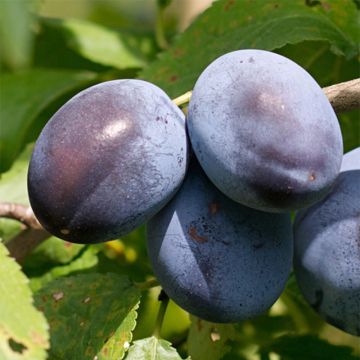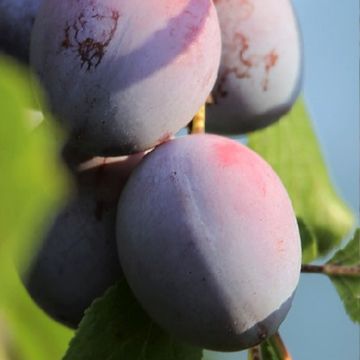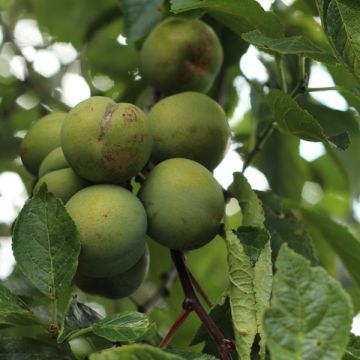

Prunus domestica Président - Common plum


Prunus domestica Président - Common plum
Prunus domestica Président - Common plum
Prunus domestica Président
European plum, Common plum, Garden plum
This item cannot be shipped to the selected country
Oversize package delivery charge from €6.90
Delivery to Corse prohibited
More information
Schedule delivery date,
and select date in basket
This plant carries a 6 months recovery warranty
More information
We guarantee the quality of our plants for a full growing cycle, and will replace at our expense any plant that fails to recover under normal climatic and planting conditions.
Oversize package: home delivery by special carrier from €6.90 per order..
Express home delivery from €8.90.
Delivery to Corse prohibited: UE law prohibits the import of this plant from mainland France to Corse as part of the fight against Xylella fastidiosa. Please accept our sincere apologies.
More information
Description
The President plum tree (or Santa Clara) is a late variety that produces large plums, with a round to oval shape, covered with a dark red-violet pruinose skin. They have a yellow-green flesh, sweet and very crunchy. Their taste quality is average, they are much better when dried to make prunes. The tree is vigorous, it has an early flowering, but it is not self-fertile: it will be pollinated by Reine Claude de Bavay. It bears fruit quickly, with a good and regular production without alternation phenomenon. The fruits ripen in September.
The plum tree or Prunus domestica President is a horticultural variety obtained by Thomas Rivers in 1894 in the United Kingdom. The original area of plum trees is believed to be Syria, not China. During the time of Roman hegemony over the region, various local fruits including plums were introduced to Rome.
This fruit tree naturally grows up to 7 meters (23 feet) tall when fully grown. The free and erect silhouette it has is appreciated, and when pruned well, it will be easy to harvest. It enjoys full sun or partial shade and grows in any type of rich, fresh, deep, or even heavy soil, but without limestone (if not grafted). Its leaves are ovate, almost oblong, with serrated-dentate edges and slightly pubescent. Flowering occurs at the end of March or beginning of April. The tree is then completely covered with white flowers that appear on the previous year's branches. After pollination by bees, the fruits form.
Plums are consumed raw at the base of the tree, in fruit salads, but also in desserts, pastries, as accompaniments to meats and dishes. They are transformed into jams, of course, but also into syrup fruits, compotes, prunes. They are also used to make brandy.
For transportation reasons, our tallest scions may be pruned before shipping. They are suitable for all common training sizes: cordons, espaliers, goblets, bush and low standard, except for high standards. If you would like more information or advice on training your fruit trees, please do not hesitate to contact us.
This fruit tree is delivered in a "ready-to-plant" rootball. During planting, the rootball should be planted as it is. The biodegradable tontine that surrounds the rootball and preserves the rootlets will decompose on its own during the plant's growth. By doing this, you ensure better establishment.
Report an error about the product description
Prunus domestica Président - Common plum in pictures


Plant habit
Fruit
Flowering
Foliage
Botanical data
Prunus
domestica
Président
Rosaceae
European plum, Common plum, Garden plum
Cultivar or hybrid
Other Plum Trees
Planting and care
The Queen President Plum Tree grows in any type of deep, loose, rich, and moist soil without excessive humidity. Ensure proper drainage of the planting hole with a thin layer of gravel. Dig a hole two to three weeks before planting, twice as wide and deep as the pot. On the day of planting, place the tree with its pot in a basin of water to moisten the entire root ball through capillary action. Add compost to the bottom of the hole. Install the tree in the hole and fill with a mixture of soil and compost. Do not bury the graft union. Firmly tamp down the soil around the base. The root ball should be completely covered. Water thoroughly.
You can add a small handful of wood ash, rich in potassium, during winter to improve fruiting.
Planting period
Intended location
Care
This item has not been reviewed yet - be the first to leave a review about it.
Haven't found what you were looking for?
Hardiness is the lowest winter temperature a plant can endure without suffering serious damage or even dying. However, hardiness is affected by location (a sheltered area, such as a patio), protection (winter cover) and soil type (hardiness is improved by well-drained soil).

Photo Sharing Terms & Conditions
In order to encourage gardeners to interact and share their experiences, Promesse de fleurs offers various media enabling content to be uploaded onto its Site - in particular via the ‘Photo sharing’ module.
The User agrees to refrain from:
- Posting any content that is illegal, prejudicial, insulting, racist, inciteful to hatred, revisionist, contrary to public decency, that infringes on privacy or on the privacy rights of third parties, in particular the publicity rights of persons and goods, intellectual property rights, or the right to privacy.
- Submitting content on behalf of a third party;
- Impersonate the identity of a third party and/or publish any personal information about a third party;
In general, the User undertakes to refrain from any unethical behaviour.
All Content (in particular text, comments, files, images, photos, videos, creative works, etc.), which may be subject to property or intellectual property rights, image or other private rights, shall remain the property of the User, subject to the limited rights granted by the terms of the licence granted by Promesse de fleurs as stated below. Users are at liberty to publish or not to publish such Content on the Site, notably via the ‘Photo Sharing’ facility, and accept that this Content shall be made public and freely accessible, notably on the Internet.
Users further acknowledge, undertake to have ,and guarantee that they hold all necessary rights and permissions to publish such material on the Site, in particular with regard to the legislation in force pertaining to any privacy, property, intellectual property, image, or contractual rights, or rights of any other nature. By publishing such Content on the Site, Users acknowledge accepting full liability as publishers of the Content within the meaning of the law, and grant Promesse de fleurs, free of charge, an inclusive, worldwide licence for the said Content for the entire duration of its publication, including all reproduction, representation, up/downloading, displaying, performing, transmission, and storage rights.
Users also grant permission for their name to be linked to the Content and accept that this link may not always be made available.
By engaging in posting material, Users consent to their Content becoming automatically accessible on the Internet, in particular on other sites and/or blogs and/or web pages of the Promesse de fleurs site, including in particular social pages and the Promesse de fleurs catalogue.
Users may secure the removal of entrusted content free of charge by issuing a simple request via our contact form.
The flowering period indicated on our website applies to countries and regions located in USDA zone 8 (France, the United Kingdom, Ireland, the Netherlands, etc.)
It will vary according to where you live:
- In zones 9 to 10 (Italy, Spain, Greece, etc.), flowering will occur about 2 to 4 weeks earlier.
- In zones 6 to 7 (Germany, Poland, Slovenia, and lower mountainous regions), flowering will be delayed by 2 to 3 weeks.
- In zone 5 (Central Europe, Scandinavia), blooming will be delayed by 3 to 5 weeks.
In temperate climates, pruning of spring-flowering shrubs (forsythia, spireas, etc.) should be done just after flowering.
Pruning of summer-flowering shrubs (Indian Lilac, Perovskia, etc.) can be done in winter or spring.
In cold regions as well as with frost-sensitive plants, avoid pruning too early when severe frosts may still occur.
The planting period indicated on our website applies to countries and regions located in USDA zone 8 (France, United Kingdom, Ireland, Netherlands).
It will vary according to where you live:
- In Mediterranean zones (Marseille, Madrid, Milan, etc.), autumn and winter are the best planting periods.
- In continental zones (Strasbourg, Munich, Vienna, etc.), delay planting by 2 to 3 weeks in spring and bring it forward by 2 to 4 weeks in autumn.
- In mountainous regions (the Alps, Pyrenees, Carpathians, etc.), it is best to plant in late spring (May-June) or late summer (August-September).
The harvesting period indicated on our website applies to countries and regions in USDA zone 8 (France, England, Ireland, the Netherlands).
In colder areas (Scandinavia, Poland, Austria...) fruit and vegetable harvests are likely to be delayed by 3-4 weeks.
In warmer areas (Italy, Spain, Greece, etc.), harvesting will probably take place earlier, depending on weather conditions.
The sowing periods indicated on our website apply to countries and regions within USDA Zone 8 (France, UK, Ireland, Netherlands).
In colder areas (Scandinavia, Poland, Austria...), delay any outdoor sowing by 3-4 weeks, or sow under glass.
In warmer climes (Italy, Spain, Greece, etc.), bring outdoor sowing forward by a few weeks.











































